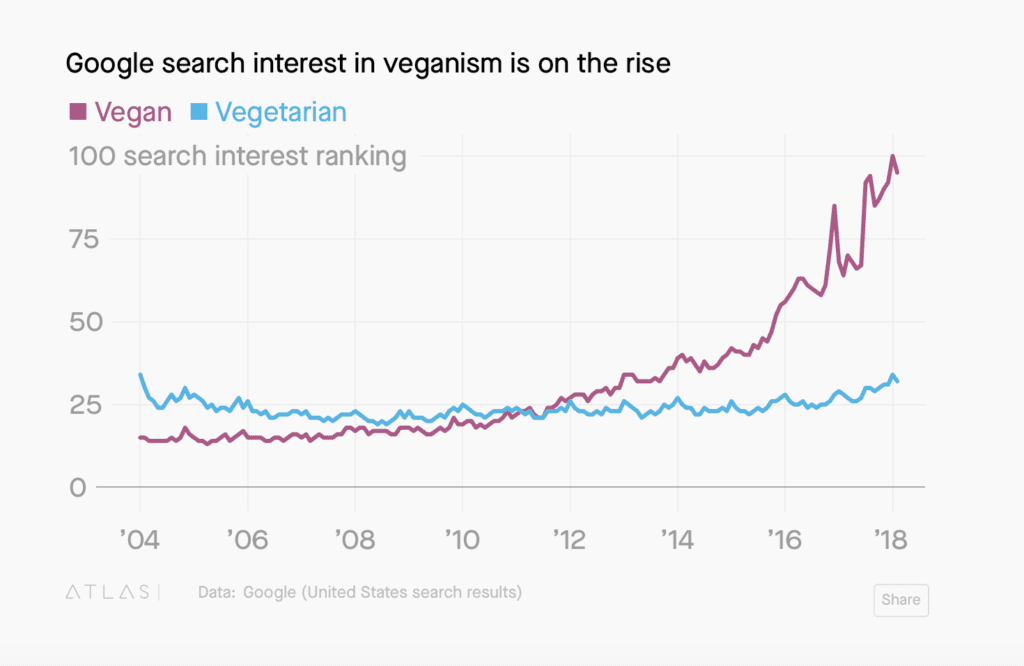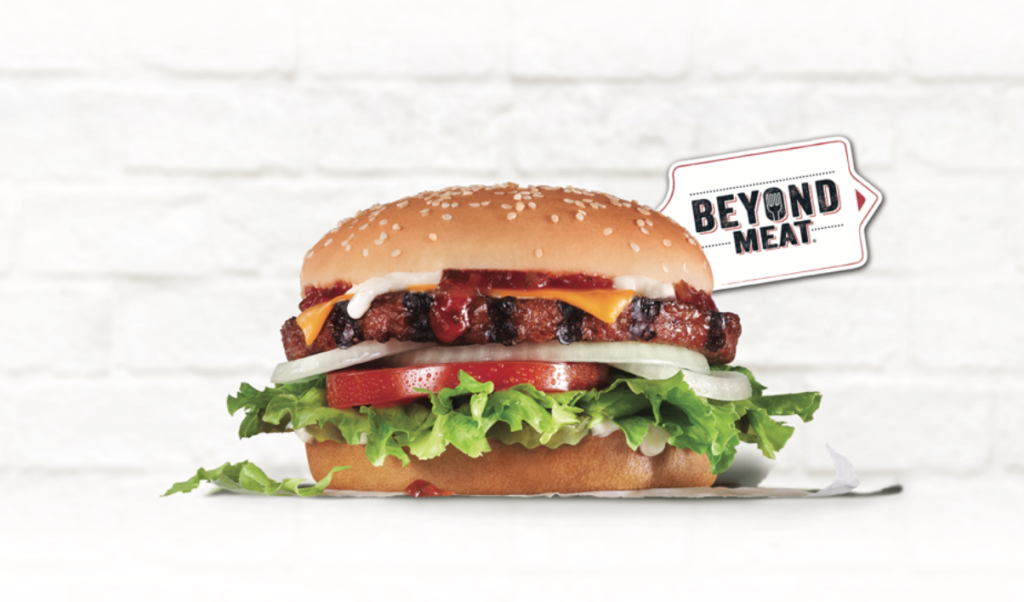Veganism is a Movement, Not a Trend
The term “vegan” is no longer a dirty word. In fact, the number of people hopping on the vegan train has grown exponentially in recent years, with news outlets declaring 2019 “The Year of the Vegan”.
The word “vegan” no longer conjures up some alternative way of life, embraced only by non-conformist hippies or food zealots on the fringes of society. Veganism is being embraced by many different people from all walks of life, from all over the globe, with millennials being the key drivers of this movement.
Veganism has been called a trend, but unlike a “trend” where something has its moment in the sun, peaks and then fades away, veganism is here to stay.
Veganism is not just a diet or a lifestyle. It is a movement, a social justice movement that has many ramifications for the world we live in, from animal rights to climate change to water usage to our health, and much more.

A few fun facts –
- Searches on Google for the term “vegan” have risen steadily over the past ten years, quadrupling in the five years between 2012 and 2017.
- There’s been a 600% increase in people identifying as vegan in the US in the last three years according to research firm, Global Data.
- Besides the US, countries showing a major interest in veganism include Israel, Australia, Canada, Austria and New Zealand per Google Trends.
- According to the Vegan Society, demand for meat-free food increased by 987% in 2017.
- Per the Good Food Institute, plant based sales are increasing by the double-digits in every region of the US, not just the coasts.
- Plant based sales are growing significantly, while animal based sales are declining or show very modest growth per the Good Food Institute.
- There was significant sales growth over last year of plant based ice cream, yogurt, cheese and meat per the Good Food Institute.
It’s an exciting time in the world of plant based, vegan foods. And big business is taking note. Tyson Foods, the largest US meat processor, has invested in plant based company Beyond Meat. And other meat and dairy-based companies have seen the handwriting on the wall and are getting in on the vegan revolution.
According to a recent Forbe’s article, “dairy farmers are seeking to invest in more stable products, like plant based milks, while struggling to survive in a volatile economy.” The fact is, milk is on the decline and the demand for alternative milk – almond, soy, oat, etc – is growing at a rapid rate.
And look at the fast food sector –
Carl’s Jr is now selling and advertising its Beyond Famous Star burger which features the Beyond burger. White Castle has teamed up with Impossible Burger with their Impossible Sliders and even McDonald’s is now offering a new veggie burger, the McAloo Tikki.

It’s only a matter of time before every single fast food establishment has a solid offering of vegan options. It’s all about supply and demand.
Clearly there is a vegan revolution happening!
The interest in healthy, whole, plant based foods is growing and is continuing to grow. As more people become vegan or look to reduce their meat consumption, there will be a pent up demand for more diverse offerings on menus at restaurants and fast food chains as well as at grocery stores.
So let’s look at a brief summary of some of the major reasons why people are making the switch to veganism –
Health – There are plentiful studies showing the benefits of a plant based diet over a diet heavy in animal products. Chief among them is that red and processed meats have been strongly linked to diseases such as heart disease, diabetes and some cancers. And chicken has been known to be a breeding ground for Salmonella, E. coli and other bacteria as well as being high in cholesterol. Then there’s dairy. Why are we drinking the milk from a cow, milk that is meant for her calf so that the calf can quickly grow? Why are we drinking milk from another species at all? Humans are in fact the only species that consumes milk in adulthood. Which does not make sense given 3/4 of the world is lactose intolerant.
Concerns over Antibiotics – Per a New York Times article, about 75% of the antibiotics used in the US and Europe are also used in animal agriculture to prevent illness amongst tightly packed farm animals. This widespread use in animals is causing resistance to antibiotics in humans. This is a very real threat as antibiotics may no longer work to treat certain bacterial infections such as pneumonia and urinary tract infections.
Animal Welfare – My personal #1 reason for going vegan. Thankfully, there is much more exposure today with what really happens to the animals in the meat, dairy, egg and fish industries. The dedicated animal activists working to expose truth, the rise of social media and many documentaries exposing the heartbreaking realities of what sentient animals have to endure – animals that are born into a vicious cycle of misery and death. People are realizing that there is nothing humane about slaughtering innocent lives, animals that fight to their last breath.
Climate Change – Animal agriculture has a huge impact on our environment and is a major contributor to climate change. Meat production is a significant source of greenhouse gas emissions and other particulate matter pollution in the atmosphere. “It contributes to land and water degradation, biodiversity loss, acid rain, coral reef degeneration and deforestation.” With an ever growing human population, it is simply not sustainable to continue eating animals.
World Hunger – Eating animals is not only inefficient, it is a major cause of world hunger. A staggering percentage of the world’s crops are fed to the billions of farm animals that are slaughtered every year for the meat, dairy and egg industries, not to mention the tens of billions of marine animals. Crops that could otherwise feed hungry people. We must change our eating habits if we are to feed the ever growing population of humans.
When I began this journey, I had no idea just how much we can all change the world for the better by adopting a vegan diet and lifestyle. Learning all these compelling facts only solidified my decision to go vegan.
When you take into account all the reasons to adopt a vegan lifestyle and then add in the rise of social media, in particular Instagram, which is spreading awareness on so many subjects, it’s no wonder veganism is hot, especially amongst younger people.
Currently, there are countless Instagram accounts promoting healthy, vegan food and lifestyles, animal rights accounts posting about ethics and the harsh realities of animal agriculture, and environmental accounts posting about the ramifications of a meat-based society on our planet. The list goes on.
Social media is not just about selfies….it can be used to educate and spread awareness. And it can be an excellent barometer of what’s relevant and happening in our world. Certainly, the vegan hashtag is trending, which leads me onto my next point.
Veganism is an idea whose time has come. And with any new idea, it’s interesting to see where that idea falls on the adoption curve, meaning how many people are adopting this new idea.
A scholar named Everett Rogers created a bell curve graph called the “Diffusion of Innovations” in the 60’s. Also called the Innovation Adoption cycle, this model (or graph) looks at the rate that a new idea or technology spreads amongst consumers.

This Innovation Adoption cycle has five stages that show how people (consumers) react to a new idea or product – they are listed below with a brief explanation of each:
1) Innovators – These are the risk takers. They are interested in “what’s new” and on the forefront of ideas and technology.
2) Early Adopters – These are the visionaries and opinion leaders. They are interested in pushing an idea out into the broader culture.
3) Early Majority – These people are pragmatists but open to new ideas. This is the beginning of the ‘critical mass’. They like to make informed decisions based on collecting information and the opinions of early adopters.
4) Late Majority – These people are more conservative and at the later stage of the critical mass. They tend to resist change at first but will eventually follow what their friends and families are doing.
5) Laggards – These are the skeptics. They are much slower to adopt any new ideas or products. They tend to be older, more traditional, and not influenced by outside community.
Veganism as a movement is in the early stages of this adoption cycle. Currently, I would say we’re in the Innovators / Early Adopters phase of the cycle. Ideas tend to go viral once in the Early Adopter phase, which is what we’re seeing.
Both the Innovators and the Early Adopters are pioneers and tend to be passionate about change, looking to spread information to help their cause or idea grow. So, veganism is still very much in its infancy, but this movement is rapidly growing.
So in conclusion, is veganism here to stay? That would be a resounding yes!
Veganism is on the rise and has only really just begun its ascent in the larger scheme of things or the big picture. It is a movement, not a trend. There are multitude reasons to go vegan.
Veganism is the answer to so many of our world’s issues. There will be a time in the hopefully not so distant future where animals are no longer part of the equation for our food, fashion or other needs…. a time when our food system is entirely plant based.
The future is vegan!
